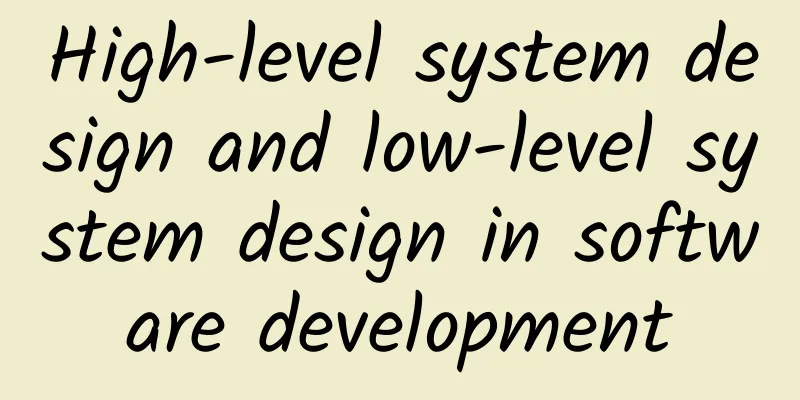High-level system design and low-level system design in software development

|
The software development cycle goes through many processes, High-Level System Design (HLSD) and Low-Level System Design (LLSD) are just two parts. Software Development Life Cycle (SDLC) goes through multiple phases like planning, requirement assessment, analysis, design, execution, documentation, testing, etc. Each phase is further divided into tasks with properly defined goals and outcomes. Analysis and design are the phases in which the actual architecture, working model, and execution procedures for building a software product are determined. Two key steps in these phases are high-level system design and low-level system design. What is Advanced System Design?High-Level Design (HLD) provides a comprehensive overview of the software development process, as well as a complete flowchart of system architecture, applications, database management, and systems and navigation. It is a blueprint that integrates the various steps and modules of developing software, their goals, variable components, results, architecture, and timelines. HLD transforms business plans into software products or services. Examples of HLDs in software development include system architecture documents, application development flow charts, etc. What is Low-Level System Design?Low-Level Design (LLD) deals with the planning, coding, and execution of the various components, modules, and steps in HLD at a single level. Each module in HLD has a unique LLD document that provides comprehensive details on how the module is coded, executed, quality tested, and integrated into the larger program. LLD provides an actionable plan by deconstructing HLD components into working solutions. Examples of LLD in software development include shopping cart integration, security testing, user interface design, etc. Difference between HLD and LLDHLD and LLD also have different functions and uses, such as high-level programming language and low-level programming language. Macro and Micro Architecture and DesignHLD is a macro design that provides a bird's eye view of the software development process. It includes diagrams, flow charts, navigation details, and other technical requirements that will form the crux of the development process. In addition to flow charts, diagrams, navigation information and technical requirements, LLD also provides comprehensive information about the step-by-step execution of each component of HLD. It deals with software development at a micro level. Each component of the HLD has a unique LLD document. Development timelineThe HLD precedes the LLD stage. Once the HLD is in place and approved for execution, work on the individual LLDs can begin. HLD begins after the planning and requirements phases are addressed and has no other dependencies. On the other hand, LLD requires execution in a specific order. Some modules must wait to execute until other modules are completed. LLD belongs to the design phase of SDLC, while HLD belongs to the analysis phase of SDLC. PurposeThe purpose of the HLD is to list the functional aspects of the various modules and the end results. The purpose of the LLD is to detail the logic and execution of each module in the HLD. StakeholdersThe Solution Architect is responsible for creating the HLD document. It can have internal and external stakeholders such as the review team, design team, customers, and managers who are responsible for understanding the software metrics. LLD is handled by software developers, web administrators, security engineers, etc. within a company or vendor team. LLD is usually limited to internal stakeholders. Target AudienceThe target audience for HLD documents are managers, customers, and software development teams. Software engineers, coders, testers, and developers working on the project are the target audience for LLD documents. Expected ResultsThe result of HLD is a software product or service that is ready for delivery to the end user. The result of LLD is the completion of a single module of HLD, such as the coding or testing phase. Understanding Software Design DocumentsIn addition to technical requirements and other implementation details, software design documents outline the structural, functional, and logical aspects of developing a software product or service. Whether the design deals with the macro level or the micro level of execution, programmers and other stakeholders should know and understand the scope and individual steps of the software development process. |
<<: iOS 16 beta 7 released, iOS 16 official version is coming
Recommend
A timely help? NIO completes $100 million convertible bond financing
Recently, NIO announced that it has signed a conv...
Analysis of Weibo Fanstong advertising in Q2 2020
According to data from the 2019 Weibo V Influence...
Eating 3 pieces of this fruit is enough for a day's vitamin C! Here are 5 ways to eat it, saving money and making it delicious
In the hot summer, eating a lychee is sweet and r...
A guide to promoting large-scale events!
Be a long-termist and try to maximize the experie...
Why can't you hit the fly?
In the kitchen or restaurant, you can always hear...
OPPO Find X dismantling: dual-track periscope hides mysteries
OPPO Find X is the first domestic Android model t...
Taking Meituan Takeaway’s personal report as an example, let’s talk about user personal behavior reports!
We try to reflect the value of our product throug...
Copywriting skills: 16 common UI copywriting mistakes
There are many techniques in copywriting design, ...
Nexus 5 battery life shortened after 5.0 upgrade
Nexus 5 users who upgraded to Android 5.0 in the ...
Google Play's return to China is highly anticipated: it is expected to reshape the Chinese mobile game market
According to the technology blog VentureBeat, Chi...
Guide to listing on Android App Market!
The company's product line expanded and multi...
Silver brings Apple's Swift to the .NET and Java worlds
Silver is a free implementation of Apple's Sw...
This spring "epidemic" is torturing countless Chinese people! The "real culprit" is actually...
When spring comes and flowers bloom, it is the da...
How to do viral marketing well? 3 types and 4 elements you must know
Viral marketing is a very effective way to achiev...
Cook’s iPhone moment has not come yet!
Click to participate in the 51CTO website content...









